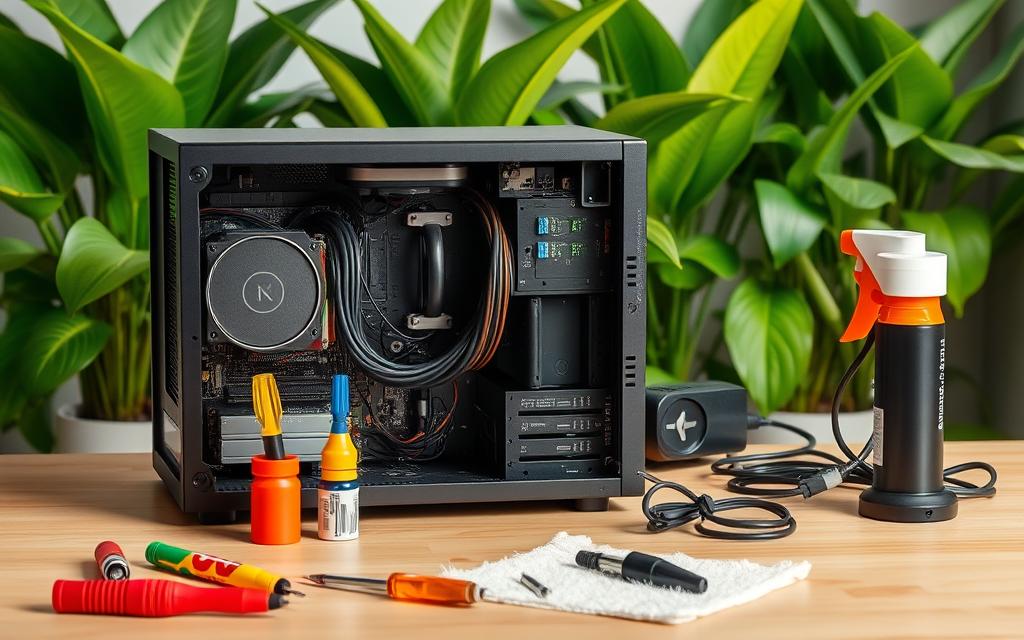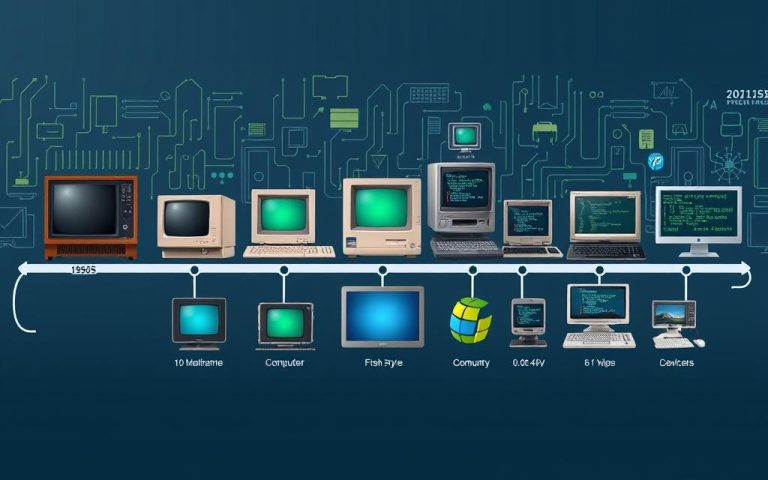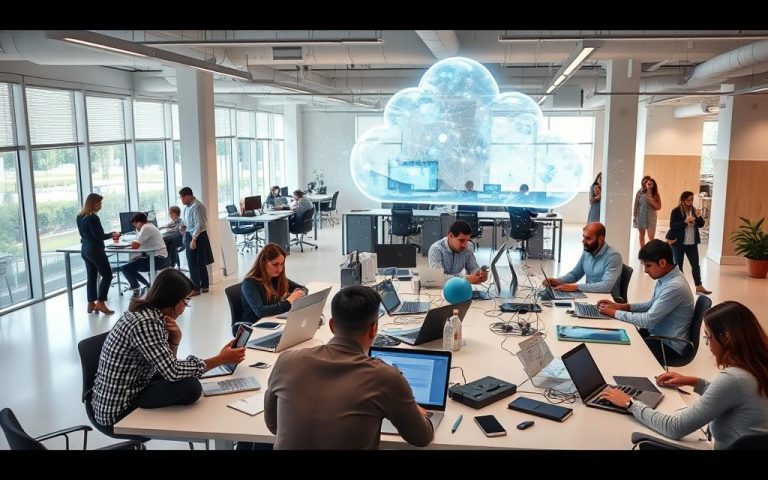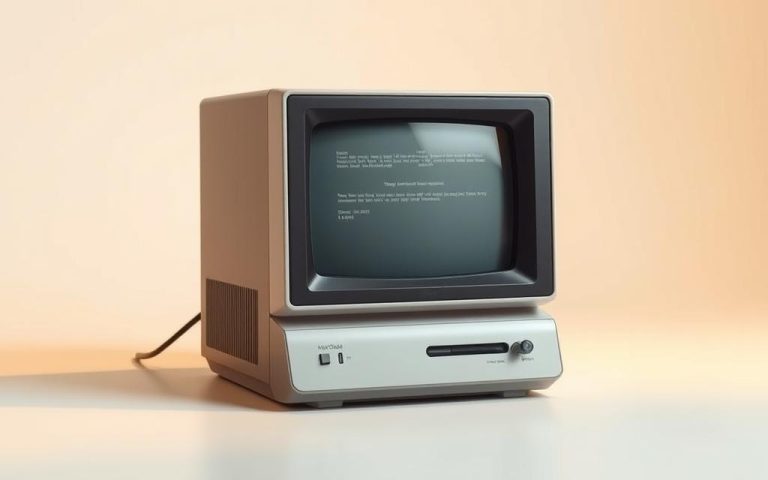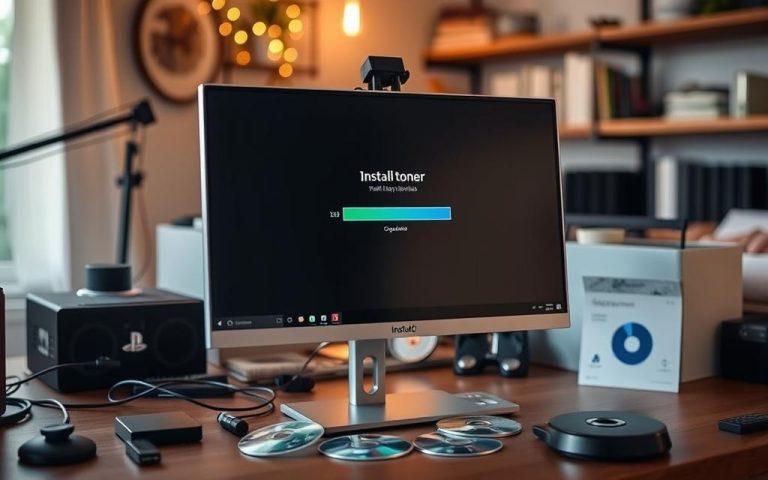How to Properly Maintain Your Computer Equipment and Systems
Keeping your computer in top shape is key for its performance and safety. Experts say regular care can stop hardware problems and boost how well your system works. This means cleaning up old browser files and keeping your software up to date.
Good maintenance habits can also save your data and make your computer run better. You can do this by managing what starts up, defragmenting your hard drive, and using disk management tools. Also, getting rid of unused programs and old files can make your computer faster and more efficient.
Don’t forget about software updates. They keep your system running smoothly and efficiently. By keeping your software current, you ensure your computer stays safe and performs well. Following these tips will help keep your computer in great condition.
Understanding the Importance of Computer Maintenance
Regular computer maintenance is key to keeping your system running well for longer. By doing routine checks and tasks, you boost system performance, lower the chance of hardware failures, and save money in the long run. For example, cleaning up browser junk and removing unused programs can make your system faster.
A well-kept computer means faster speeds, avoiding delays at work. Also, tackling problems early through regular checks stops big issues. This keeps your system running smoothly.
- Reduced risk of hardware failures
- Improved system performance
- Cost savings over time
- Enhanced security through updated antivirus software and patches
Regular maintenance extends your IT equipment’s life, cuts IT support costs, and stops breakdowns. Cleaning parts like the CPU fan protects against wear and tear. Data backups also prevent loss from hardware failure or cyber-attacks.
Essential Tools and Materials for Computer Maintenance
Keeping your computer in top shape requires the right tools and materials. You’ll need cleaning supplies like compressed air and soft cloths. These help keep your computer’s outside and inside clean. Also, diagnostic software is key for finding and fixing hardware or software problems. And don’t forget backup devices like external hard drives or cloud storage to protect your files.
Other important tools for computer care include:
- Screwdrivers and other tools for opening the computer case
- Anti-static wrist straps to prevent damage from static electricity
- Multimeters and other tools for checking and fixing hardware
- Cable ties and velcro straps to keep cables neat
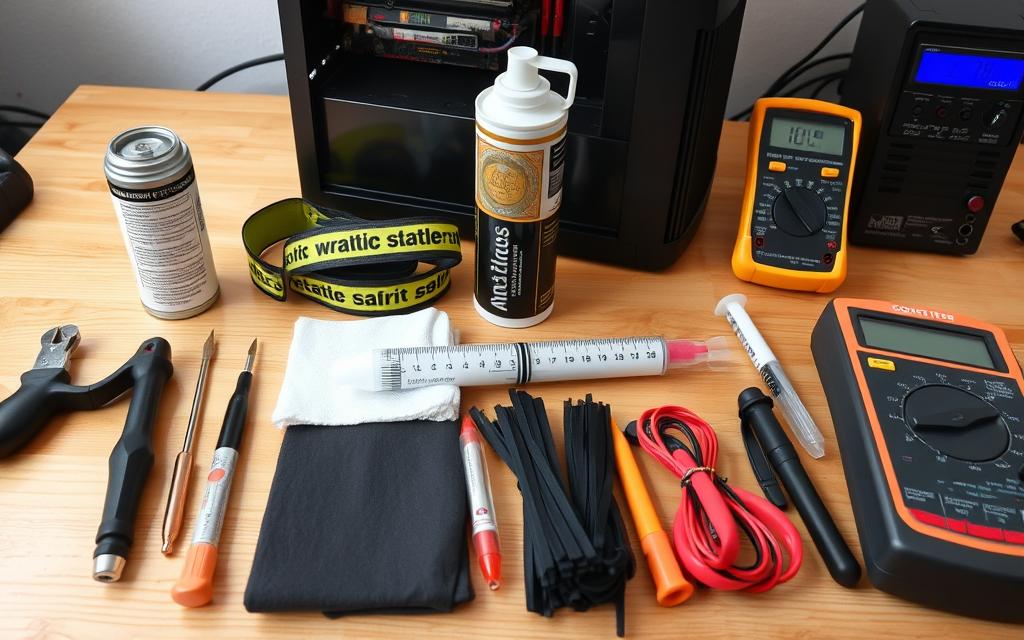
For software, having various tools is vital. You’ll need diagnostic software for finding and fixing problems. Also, backup software to keep your files safe, and security software to guard against malware. With the right tools and materials, your computer will run smoothly. You’ll be able to fix any issues that come up.
| Tool | Description |
|---|---|
| Cleaning supplies | Compressed air, soft cloths, and other materials for cleaning the computer’s exterior and interior |
| Diagnostic software | Software for identifying and troubleshooting issues with the computer’s hardware or software |
| Backup devices | External hard drives, cloud storage services, and other devices for backing up important files and data |
Physical Cleaning and Hardware Care
Regular physical cleaning is key to keeping computer gear in top shape. It means cleaning the outside parts, like keyboards and mice, and the inside bits, like CPUs and motherboards. Experts say using a microfiber cloth on LCD screens can stop damage and make them clearer.
Good hardware care also means managing cables well. This stops cords from getting damaged and makes it quicker to unplug things. You can use cable organizers and keep things neat. For more on keeping IT hardware in check, check out the IT hardware maintenance guide.
Also, keeping your computer cool is vital to avoid overheating and damage. Make sure there’s good airflow, tidy up your space, and use cable organizers. These steps can help your computer last longer and avoid harm.
- Regularly cleaning external components, such as the keyboard and mouse
- Using a microfiber cloth to clean LCD screens
- Implementing cable management techniques to prevent damage to cords
- Ensuring proper ventilation maintenance to prevent overheating and damage
How to Maintain Computer Equipment and Systems Effectively
Regular maintenance scheduling is key to avoid hardware failures and boost system performance, as Jeremy Mercer, Computer Specialist, points out. Tasks like disk cleanup, disk defragmentation, and updating operating systems are important. For example, Windows 10 checks for updates daily, keeping systems current with performance boosts.
Also, disconnecting from networks helps stop malware and unauthorized access. This is vital for keeping systems safe.
Effective system monitoring helps spot issues early. This means checking for updates, watching system performance, and running antivirus scans. Weekly antivirus scans are key to keep computers free from malware.
Also, cleaning the keyboard and computer case regularly is important. It stops buttons from getting stuck or hard to press.
Troubleshooting is needed to fix problems fast and well. It involves finding the problem’s source, running diagnostic tests, and applying fixes or updates. By following these steps, computers stay well-maintained, secure, and work well.
Regular maintenance can extend a PC’s lifespan by 5-8 years, and proper care can prevent costly repairs and data loss.
By focusing on maintenance, monitoring, and troubleshooting, users can have a reliable and safe computing experience. This reduces downtime and boosts productivity.
Software Maintenance Best Practices
Regular software updates are key to keeping your computer safe and running well. This means getting software updates to fix bugs, managing driver management for hardware, and using software optimization to boost speed. These steps help avoid crashes, data loss, and security problems.
Important maintenance steps include setting a regular update schedule, running system checks for security, and using backups for your data. Also, make sure your devices have enough free space to run smoothly and without interruptions.
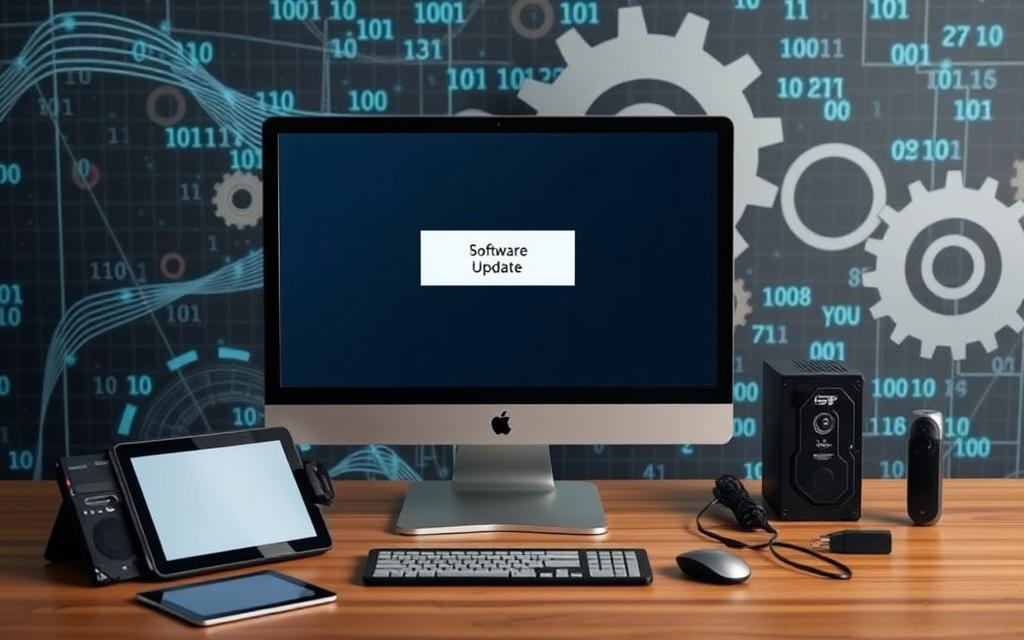
- Update virus and firewall definitions weekly to ensure the latest protection against intrusions and malware threats.
- Run malware protection software, such as the free version of Malware Bytes, to maintain computer security.
- Use Windows Disk Cleanup to delete unnecessary files and improve PC performance, running this tool about twice a month.
By sticking to these maintenance tips, you can keep your computer running well for longer. This helps avoid common problems and keeps your system performing at its best.
Data Management and Backup Strategies
Effective data management is key for any business. A strong data backup strategy is essential. It means having a plan that uses the right backup devices and keeps data safe.
Popular data backup choices include external hard drives, cloud storage, and NAS devices. Each has its own pros and cons. The right one depends on the business’s needs. For instance, cloud storage is easy to use but might not fit large data needs.
When picking a backup device, think about storage, speed, and security. Cloud services like Google Drive, iCloud, and Dropbox are popular. They offer encryption, password protection, and scheduling for backups.
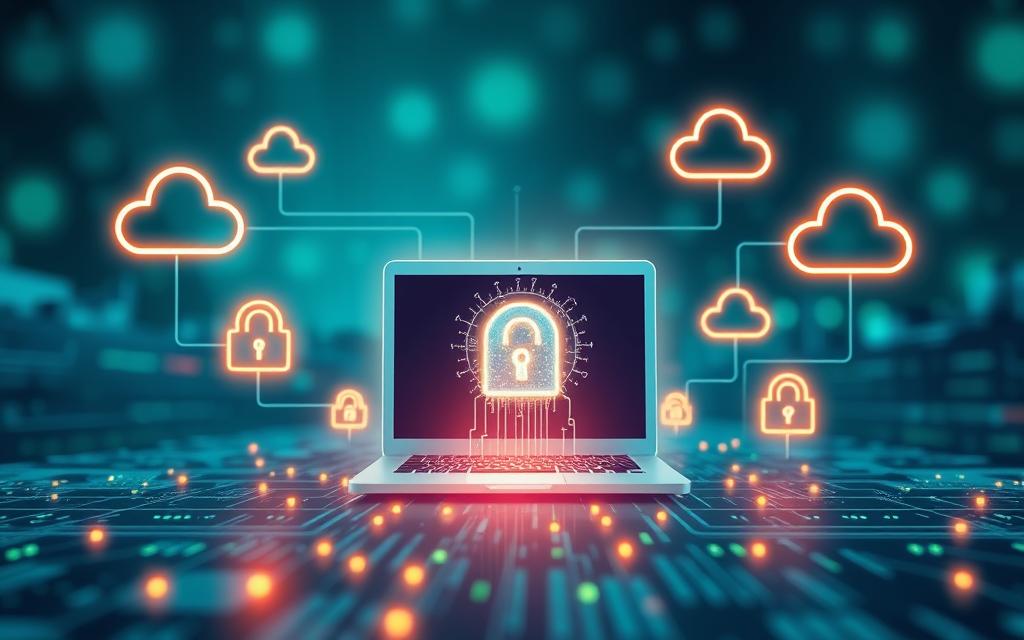
- Reliability: NAS devices are built to be reliable, even during power outages.
- Security: They have advanced security like encryption and password protection.
- Scalability: NAS devices can grow or shrink as your needs change.
It’s vital to test data backups regularly. This ensures they work right and all data is there. You can test by restoring a small part of data and checking it’s complete and correct.
Security Measures and System Protection
Keeping your system safe from threats is vital. Antivirus management is key to protect your data. Windows has a built-in firewall that starts automatically, giving basic protection.
Setting up your firewall right is also important. It stops unwanted access to your system. Regular scans find and remove malware, keeping your system safe. Microsoft offers tools like Windows Security and Microsoft Defender Offline for all types of users.
Here are some top tips for keeping your system safe:
- Use anti-virus software to fight malware from phishing attacks
- Choose strong passwords, like three random words, for better security
- Always update your operating system and software for the latest security fixes
By following these tips and using antivirus, firewall, and scans, you can greatly improve your system’s security.
| Security Measure | Description |
|---|---|
| Antivirus Management | Prevents malware and other security threats |
| Firewall Configuration | Prevents unauthorized access to your system |
| Regular Security Scans | Detects and removes malware, ensuring system security |
Troubleshooting Common Issues
Keeping your computer in top shape is key. Regular checks can stop hardware failures and boost performance. Jeremy Mercer, a Computer Specialist, says finding and fixing problems early is vital. Issues like slow performance and faulty peripherals need attention.
Some common problems include:
- Power button not starting the computer
- Applications running slowly
- Computers freezing
- Mouse or keyboard not working
- Sound issues
- Blank screen
To solve these problems, follow a clear plan. Check the power cord and outlet for power issues. For slow apps, try updating or scanning for viruses. If your computer freezes, try force quitting apps or restarting Windows Explorer.
Sometimes, you might need to look online for help. Be patient and thorough in your troubleshooting. This way, you can fix issues quickly and keep your computer running smoothly. Regular checks and diagnostics prevent problems and keep your computer efficient.
| Issue | Troubleshooting Steps |
|---|---|
| Power button not starting the computer | Check power cord and outlet, surge protector, or ensure charged laptop battery |
| Applications running slowly | Update application or run virus scanner |
| Computers freezing | Force quit applications, run virus scanners, check hard drive space, or restart Windows Explorer or Finder |
Conclusion: Maintaining Long-term System Health
Being proactive with computer maintenance is key for keeping your systems healthy and running well. Regular upkeep boosts your computer’s life and lowers the chance of expensive breakdowns and data loss.
Keeping your computer clean, updating software, backing up data, and securing it helps it last longer. Studies show businesses that focus on maintenance see their equipment last up to 78% longer. This proves the value of regular care.
Prevention is better than cure. Taking care of your computer now means it will work efficiently and safely for years. This saves your business time, money, and stress. Stay on top of maintenance and enjoy the benefits of a well-kept IT setup.
FAQ
What are the benefits of regular computer maintenance?
Regular computer maintenance boosts system performance. It also cuts down the chance of hardware failures and data loss. Plus, it saves on repair costs and makes your computer last longer.
What essential tools and materials are needed for computer maintenance?
For computer maintenance, you’ll need cleaning supplies, diagnostic software, and backup devices. It’s key to pick the right tools for your needs.
How do I properly clean and care for my computer hardware?
Proper cleaning and care for your computer involves a few steps. Start by cleaning the outside, then remove dust from inside. Manage your cables well and ensure good airflow to prevent dust.
What are some best practices for maintaining computer equipment and systems effectively?
Effective maintenance combines regular upkeep, system checks, and troubleshooting. Regular maintenance, monitoring, and fixing common problems are all part of it.
How do I ensure my software is properly maintained?
To keep your software in top shape, update your operating system and drivers regularly. Also, optimize software performance and use the right tools for maintenance.
How do I create an effective data backup and management strategy?
Creating a solid data backup plan is key. Choose the right backup devices and ensure data security. This is vital for managing and backing up your data effectively.
What security measures should I implement to protect my system?
To protect your system, use antivirus software, set up a firewall, and run regular security scans. These steps are essential for keeping your computer safe and secure.
How do I troubleshoot common computer issues?
Troubleshooting common problems is a big part of computer care. It includes fixing performance issues, checking hardware, and solving software conflicts. A good troubleshooting plan can prevent failures and boost performance.

